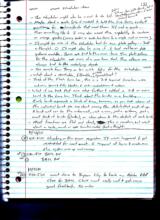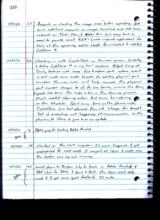|
Basic Assignments
|
Options & Settings
|
Main Time Information
|
||||||||||||||||||||||
|
|
|
|
|
||||||
|
||||||
|
|
|
Notes:
|
|
-On the scheduler application, I am not limited to a Flash only interface. I can mix whatever technologies I need to piggy back on existing technologies. I could use ColdFusion, tables, css, div tags, Java Script, Flash, ActionScript, static graphics, MS Excel spreadsheets, pdf and basic html pages. -Scheduler app: 1. Design it first – paper. 2. Then static screen shots. 3. Then dynamic and interactive. -Maybe think of output to a spreadsheet with comments. Might be pretty simple. Scheduler ideas and thoughts: - The scheduler application should also be able to handle a micro blog for a customer, user/employee, vendor or any other item. - Allow some sort of point and click options to each scheduler or event. We might even be able to tie-in a recipe to the scheduler so that once an invoice is needed it already know what line items to use. Have everything ready for when check out, check in, or payment happens. - I want a tight link and tie-in between the scheduler and the shopping cart (both quotes and invoice carts). - As far as a customer time clock, say you had 13 different scheduler blocks for a customer (even in the past or in the future). It would be cool to pull in all of the blocks and show them as invoiced (tied to the correct invoice #). (Note: future times might need to be mapped to the B.S.) It might also be cool to allow the user to show details or sum up all items under one new item. Basically allow the user to decide how the final invoice looks to the customer. - Maybe think of some sort of time based model that acts like the flex grid. It is fully connected but doesn’t interfere with normal traffic. Maybe another full application on top of the main working application. Time goes in both “know” directions. Think 3rd dimension. Multiple pieces may share the same time space but each may have a different life or life cycle. - Time needs to be the 1 (one) and whatever play in that space is the many. - Allow multiple bookings in a single slot of time. Also don’t force ends to match-up perfectly. Let it flow like water… fully user maintained. If needed, show some extra flags for potential problems, double, triple, quadruple, bookings, overlaps, gaps, disconnects, waiting lists, etc. Allow people to put and place what they want into the time-based model. - Allow users to go back in time (if needed). Basically, time as it if forecasted (future – somewhat unknown), time as it happens (maybe too busy to change something) and time in the past what did happen or what was perceived. The key there is to add a history date/time stamp and let it flow. The actual history (behind the scenes) will become the audit trail if needed. - The scheduler might also be a cool to do list feature. If an item gets done, let it stay there, otherwise, allow it to be pushed forward. - Maybe start a quote (only if needed) to hold the line items, costs and quantities for time blocks that need them. If not a quote… then something like it. I may also need the capability to combine or merge quotes (many quotes or quote line items to a single cart or invoice). - It might be nice if the scheduler had its own photo gallery – just a thought. It might also be nice if it had reflexive photo galleries available. These are tied to the main items. The photo gallery for the scheduler is more of a one-time deal. The others are always tied to the underlying object. - See emails from our associate on their wish list for the scheduler. (10/26/10) - What about a searchable, filterable, printable spreadsheet? - Think of the Flash time line, this is a 2-D layered timeline with actions, spans and fills, blanks and color-coded items and actions. - What if we took that one step further and added a 3-D or cubic level to the time line. Think about the bricks in a building – each brick represents a block of time; however, as you look closer at the individual brick you can start seeing the details that make it up. A brick wall can be the entire wall, just a row, just a column, just a small block of bricks (cluster), or clear down to the details of each brick. - Most timelines are flat and straight. This is random but what about a cycle, round or many timeline mode? Just a thought. |




